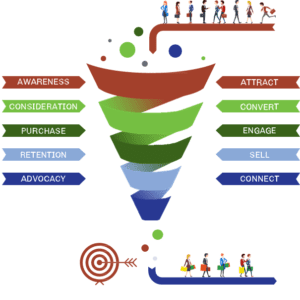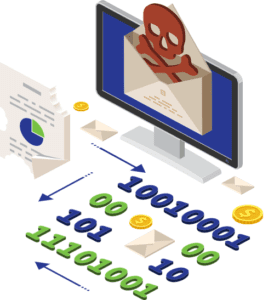The relationship between business and buyer is not always a simple one. Even if you’re able to stand out from the regular inbox clutter and make yourself notable, actually managing to turn a lead into a sale is a multifaceted process.
This is where lead nurturing can help you simplify things.
Proper lead nurturing is about developing relationships with your potential customers – not only at every part of the sales funnel, but at every part of the buyer’s journey. This can be accomplished using a strategic lead scoring system, a dynamic content marketing plan, and a data-centric approach to measurement and analysis.
Understanding the Sales Cycle
Even before analyzing and categorizing different buyer personas, effective lead nurturing begins with understanding the sales funnel. This not only helps distinguish the point of the sales cycle buyers are in, but it also reduces your guesswork in targeted marketing.

Top of the Funnel
The leads at the top of the funnel might not even be aware of your business, or if they are, the awareness is minimal. At this point, they are simply seeking information or “testing the waters”. Studies consistently show how the right information inspires action, and how something as simple as an easy to find “about us” page or a clear company narrative can further entice potential buyers.
Middle of the Sales Funnel
Leads in the middle of the funnel are those who you’ve effectively hooked with your story and candor, but who are looking for a unique product or service that resonates with their specific needs. This is a crucial step in your lead nurturing process, as potential buyers will be enticed by different things (more on that with content focus). A focus on what sets you apart helps provide buyers with a visible reason why your product or service is the correct one.
Bottom of the Sales Funnel
These are the customers who are ready or nearly ready to purchase. Keep in mind, while making your pitch at this stage, a hard sell might not be necessary since the buyer has usually already made up their mind. This is the part of the funnel that helps establish the groundwork for a solid business relationship. Making sure the purchase interaction is smooth and convenient goes a long way in creating a customer for life.
Through the Sales Funnel
It may seem strange that the sales cycle would continue, but following up after a sale is completed is equally important. It draws customers back in, thus growing your lifetime customer value and opening up the opportunity for referrals and additional business.
Focus Your Content
Remember: Lead nurturing is not a “one-size-fits all” strategy. Research the subject and you’ll find a strong focus on targeted content to improve marketplace tactics.

However, in order to do this effectively, you may need to do a little housekeeping.
First off, you need to take an in-depth look at your buyer persona(s). A buyer persona is essentially a profile of your target customer. It focuses on who that person is and what they are looking for in a product or service. Often, a company will be able to easily identify one or more personas for their business and build them out through surveys, interviews, focus groups, social media, and more.
If a few different personas emerge, you will need to create an assortment of targeted content designed to nurture each of them based on:
- Initial interests (Why are they a lead in the first place?)
- Goals (What do they hope to get out of their relationship with you?)
- Business objectives (What can you do to trigger them to stay in the content funnel/marketplace?)
Focus on answering the tough questions your personas have brought up. If there are intricacies to your product or service that might be confusing or complicated, content can be created to help clarify. Content that educates and focuses on being completely transparent goes a long way in nurturing a lead.
Nurture Beyond Email
Although traditional lead generation relies heavily on email campaigns, things are expanding in different directions. The sheer volume of clutter plaguing most inboxes makes it hard to stand out, and whatever intimacy was once associated with email correspondence is mostly gone.

Though emailing is an effective, important tool for jump starting the lead nurturing process, you have a lot more work to do if you want to see positive results.
Social Media
Social media is a great tool for lead development, but also helps build lasting relationships with those leads. Even the smallest, most subtle gestures such as following a potential buyer on Twitter, liking their LinkedIn update, or demonstrating thought leadership with a post can go for a long way in developing lead relationships.
Audience-Specific Re-targeting
Beyond the standard lead chasing and follow-ups, re-targeted marketing strategies can be particularly helpful in generating new, lasting leads. Taking a proactive approach to establishing connections in the specific spheres that your regular buyer personas occupy has proven far more effective than relying on email as a broad reaching Hail Mary.
Take Time to Analyze
No matter what ‘quick fix’ you read on nurturing leads, it isn’t a perfect science. Changing marketplaces, business structures, location, etc. all play into how your specific business generates leads, and there’s never going to be one final, correct answer.
The absolute best way you can cement the proper lead nurturing practices is to measure your performance.
There are fundamental metrics to consider when any lead nurturing campaign is undertaken, such as:
- Open and click through rates with email campaigns
- Click through rate with a targeted ad placement (PPC, social media)
- Subscribe, like, and unsubscribe rate with SMA and social media content
- Conversion rate on website call-to-actions
These metrics can change based on business and product, but industry standards should provide a stable benchmark by which to judge valuable metrics.
Beyond the data, it is also a must to evaluate your internal outreach practices. Even when current practices are converting well, they could always convert better.
Don’t be afraid to test the water and always be focused on where you can improve.
Read more at the ROI Revolution blog!



